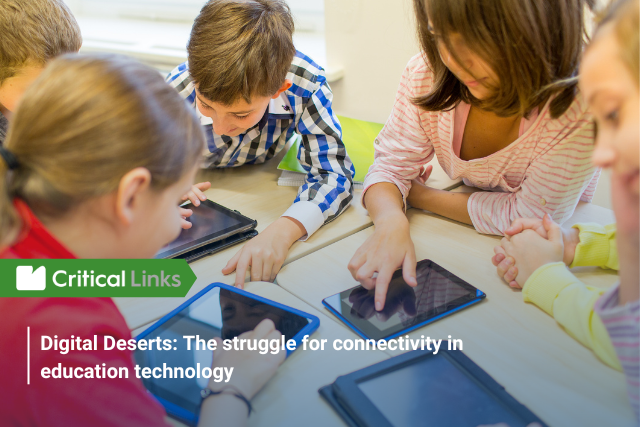
Digital Deserts: The struggle for connectivity in education technology
Imagine a world where some kids have all the cool gadgets and lightning-fast internet, while others find it hard just to get online for a few minutes a week. The result is a massive disparity in both opportunity and outcome for the next generation which leads to economic and social chaos. That’s the digital divide—a huge difference between those who have easy access to technology and those who face challenges in getting connected for learning.
In today’s digital age, access to education relies heavily on connectivity. However, the existence of ‘digital deserts’ poses a significant challenge to ensuring equitable learning opportunities worldwide. These deserts are caused by both geographic and economic discrepancies which result in limited or unreliable internet access, hindering educational progress and leaving many students and communities on the disadvantaged side of the digital divide.
The digital divide exacerbates educational inequalities, disrupting the equilibrium within the educational landscape. Traditionally confined by physical walls, classrooms now extend into the digital realm – in this way, they mirror virtually every other aspect of developing civilization (i.e. commerce, entertainment, news, information transfer, etc.). However, for students lacking access to online resources, this evolution poses a considerable challenge. Education seems to have been left behind.
The future impact of this dynamic is of great concern; by impeding access to educational resources, the digital divide perpetuates disparities in digital literacy skills that are fast becoming fundamental life skills. Even when given basic access to technology, students aren’t able to develop the necessary skills to utilize it effectively for learning purposes. This further widens the gap between those who are digitally fluent and those who are not, creating barriers to academic success.
Deprived of the ability to engage in virtual lectures, collaborate on digital platforms, or submit assignments online, these individuals are effectively excluded from contemporary educational paradigms. However, in response to these complexities, educational micro-clouds emerge as a glimmer of hope. They function as self-contained digital learning environments in the school that offer a variety of educational resources, such as curriculum and courses to follow; teaching materials and experiences; and rich content such as videos, texts, and digital learning applications to bring students along. Even without the broadband connectivity that remains so elusive to many regions.
By hosting educational content locally, micro-clouds allow students and educators to access resources without relying on a constant internet connection. The adoption of micro-clouds isn’t just about embracing technology; it’s about empowering communities. In addition to filling gaps in education, micro-clouds also play a crucial role in reshaping the educational landscape. They bring about a transformation in how knowledge is shared and accessed, reshaping the educational environment as a whole. By providing more equitable access to educational content, micro-clouds ensure that no community is left behind in the pursuit of knowledge.
Therefore, it’s imperative that governments and school administrators recognize the potential of micro-clouds as a solution to progress towards a future where access to knowledge is no longer limited by geographical or financial barriers. By adopting and promoting the use of micro-clouds, we can reduce the digital divide and make education truly accessible to all, regardless of their location or socioeconomic status.
In harnessing the potential of educational micro-clouds, we’re taking concrete steps toward a future where access to knowledge knows no boundaries. It’s time to act decisively, to implement these innovative solutions, and to ensure that every student has the tools they need to succeed. Let’s work together to close the digital divide and create a world where education truly belongs to everyone.
